#common p&p 2005 w
Text
Hand flex this, rain proposal that WHAT ABOUT the half hug from behind lizzie gives her mother after lydia and wickham leave longbourn, i wanna talk about THAT
#i only really noticed it last night#and not to be tmi but that's the exact same thing i do with my mum in that kinda situation#i'm not gonna ramble about it in the taga bc i could go on and on#but that simple gesture and both their reactions are very underrated omg#common p&p 2005 w#pride and prejudice#pride and predjudice 2005#lizzie bennet#mrs bennet#jane austen
267 notes
·
View notes
Text
A note on coverage of The Neverending Story on this blog
The Neverending Story isn't the most obvious choice of follow-up project to The Locked Tomb.
It's an incredibly old story, first published even before I was born, and I've been around a good while. It's got nothing in common tonally or thematically. There aren't any pop culture references I expect to be able to draw out because I am not German, and while I've studied it to a Duolingo baseline as well as in a course in school, I don't have a founding in their pop culture, past or present, to be able to pick out any references anyway.
(And yes, if you didn't know, it's a story in translation! An art form in itself. My copy is the 1983 Ralph Manheim translation, though it's a 2005 reissue edition. I know that some other English translations exist, though, so if anyone has one of those, please feel invited to comment on anything you think seems a little different from how I describe it, or where my direct quotes differ from yours!)
But it is a great and nearly timeless story about stories, something to sink my teeth into over the summer.
It's been many years since I read the book or watched the films the writer disavowed and even asked that his name be removed from the credits of, so I'm spoiled for this one, but not so much that I expect full-spoiler weekend posts.
So, whether you've read it recently, or long ago, or never at all, please be welcome with me on this journey into The Neverending Story.
Link index
Introduction
A | B | C | D | E | F | G | H | I | J | K | L | M | N | O | P | Q | R | S | T | U | V | W | X | Y | Z
2 notes
·
View notes
Text
Herpes virus type I-infected disorders affect the harmony involving Treg along with Th17 cells in recurrent hsv simplex virus labialis individuals.
Additionally, throughout man CML-CP instances, we reveal that EVI1 is very depicted in come cell-enriched CD34+ CD38-CD90+ small percentage at single-cell level. Here is the initial report to explain directly that Evi1-high leukemic tissue them selves contain the superior possible ways to Evi1-low tissue in oncogenic self-renewal, which illustrates the role involving Evi1 as being a valuable and a practical gun associated with CML originate tissue.Background/Aims: Inside gastroenteropancreatic neuroendocrine malignancies (GEP-NETs), primary wounds is not resected if the individuals have got remarkably sophisticated ailment or even when the main websites are undefined. This kind of GEP-NETs can't be assessed using Ki-67 or mitotic catalog. The objective of these studies ended up being check out the prospects of GEP-NETs which were ungraded through Which G1-3 certifying (U-NET team). Technique: Involving Two thousand as well as Next year, 70 patients together with infrequent GEP-NETs had been treated from each of our institution. Your diagnosis regarding patients ranked because brand new Which grading (G-NET team) had been in contrast to that regarding the particular U-NET party. Cox proportionate risk regression examines had been carried out for you to estimation danger elements pertaining to overall emergency (Operating-system). Benefits: All round 1-, 3- along with 5-year survival charges were 90.7%, 79.9% and also 74.9%, respectively. The chances percentage (Or perhaps) associated with sufferers with synchronous liver metastasis and U-NET has been One particular.3 (p=0.02) and Five.Eighty-four (p=0.002), respectively. Multivariate looks at associated with Computer itself according to standard qualities unveiled the only unbiased threat step to become U-NET (Or perhaps, Several.95; p=0.02). A conclusion: The actual dangerous potential involving U-NET could be a minimum of that of G-NET, while WHO-G3 individuals possess the most detrimental prognoses in the G-NET group.Qualifications & aims: HIV-infected shot medicines customers (IDUs) are acknowledged to get high prices associated with co-infections. A couple of reports can be found about comorbidities amid HIV-infected IDUs within India. We all accomplished a retrospective examine in order to analyze information in comorbidities within Asia as well as treatment problems experienced whenever dealing with HIV-infected IDUs inside Asia. Methods: The retrospective graph and or chart overview of 118 HIV-infected IDUs that accessed treatment with the YRG Middle for Substance Abuse-Related Investigation, Chennai, involving August 2005 as well as Feb 2006 was over. Demographic, research laboratory and specialized medical info was taken from medical documents. Detailed group as well as specialized medical characteristics and distributions of comorbidities across CD4 cellular count BAY-293 purchase strata have been examined. Results: All IDUs were men which has a median chronilogical age of 30.Your five 12 months. The majority ended up hitched together with average monthly cash flow below INR 3,000 each month. The particular incidence associated with hepatitis W along with D infections were 14.In search of and also 94.One particular %, respectively. Additional typical co-morbidities integrated common candidiasis (Forty three.2%), tuberculosis (Thirty-three.
#Apoptosis Compound Library#JAK inhibitor#AM1241#Bicalutamide#Lovastatin#BAY-293#RGD#Isoxazole 9#PJ34#Tubacin#Tenofovir#Urolithin A#PP2#BIBR 1532#RG108#Pazopanib#Coelenterazine#Resiquimod#Spautin-1#PF-573228#SCH900353#compound 78c#NSC 10483#MMAE#RP 13057#CGS 20267#4-MU#NSC-67574#LY-231514#TP-0903
0 notes
Text
Red kite energy

Garvin JC, Jenelle CS, Drake D, Grodsky SM (2011) Response of raptors to a windfarm. Bremer Beitr Naturk Naturschutz 7221–228Įichhorn M, Drechsler M (2010) Spatial trade-offs between wind power production and bird collision avoidance in agricultural landscapes. Ann NY Acad Sci 1134:233–266ĭürr T (2004) Vögel als Anflugopfer an Windenergieanlagen-ein Einblick in die bundesweite Fundkartei. Biol Conserv 145:79–85ĭrewitt AL, Langston RHW (2008) Collision effects of wind-power generators and other obstacles on birds. Biol Conserv 142:2954–2961ĭahl EL, Bevanger K, Nygård T, Røskaft E, Stokke BG (2012) Reduced breeding success in white-tailed eagles at Smøla windfarm, western Norway, is caused by mortality and displacement. Accessed Ĭarrete M, Sanchez-Zapata JA, Benitez JR, Lobon M, Donazar JA (2010) Large scale risk-assessment of wind-farms on population viability of a globally endangered long-lived raptor. Accessed īundesregierung der Bundesrepublik Deutschland (2015) Energiewende. J Nat Conserv 21:394–400īirdLife International (2015) European red list of birds. Nonpasseriformes-Nichtsperlingsvögel, AULA, Wiebelsheimīellebaum J, Korner-Nievergelt F, Dürr T, Mammen U (2013) Wind turbine fatalities approach a level of concern in a raptor population. RSPB and BirdLife International, on behalf of the European Commission, Sandyīauer HG, Bezzel E, Fiedler W (2005) Das Kompendium der Vögel Mitteleuropas. Knott J, Newbery P, Barov, B (2009) Action plan for the red kite Milvus milvus in the European Union. In: de Lucas M, Janss G, Ferrer M (eds) Birds and wind power. Haupt Verlag, Bernīand W, Madders M, Whitfield DP (2007) Developing field and analytical methods to assess avian collision risk at wind farms. The results clearly indicate that implementing buffer zones around nest sites reduces collision risk.Īebischer A (2009) Der Rotmilan. Furthermore, the collision probability model predicted a sharp decrease of collision risk with increasing distance from the nest. The probability of closely approaching a wind farm significantly decreased with the distance between wind turbines and nests. Red Kites frequently visited wind farms for foraging and spent about 25% of their flight time within the swept heights of rotors of the most common wind turbines present in the study sites. It is important to note that the data did not indicate displacement of Red Kites by wind farms. Most (54%) of the fixes were located within a radius of 1000 m around nests. It was found that Red Kites spent most of their time close to their nests. The collision risk was modeled in relation to the nest’s proximity to wind turbines. Data on flight height and habitat preference were collected by visual observations. Each bird was tracked for one or two breeding and non-breeding seasons. Ten breeding adult Red Kites were equipped with radio tags (seven birds) or GPS satellite transmitters (three birds). The study took place in the core of the Red Kite global breeding range in Sachsen-Anhalt between 20. The German Federal Ministry of the Environment, Nature Conservation and Nuclear Safety funded a field study to investigate why Red Kites and other birds of prey frequently collide with wind turbines, and which risk mitigation measures are most appropriate. Germany houses more than half of the world’s population of Red Kites and, therefore, has a high international responsibility for the protection of this species. Red Kites ( Milvus milvus) are the second most often reported species in relation to collisions with wind turbines in Germany.

0 notes
Photo

As I celebrate 30 years with Marquette University, I marked up a 1992 campus map to show changes. Green is for new buildings. Yellow means renovation. Red marks demolition.
A) Mashuda Hall was remodeled in 2002. Building 3 became a We Energies substation. Building 4 was razed. O’Donnell Hall was renovated in 2019.
B) The School of Dentistry opened in 2002.
C) Krueger Child Care Center opened in 2011.
D) The Commons res hall opened in 2018. Building 5, the Parent & Child Center, Boiler Plant, the Academic Support Facility were razed. Humphrey Hall was remodeled.
E) The Physician Assistant Building opened in 2019.
F) Formerly a hospital clinic, the 1700 Building is home to Occupational Therapy.
G) Campus Town West, part of Campus Circle, was completed in 1993.
H) Parking Structure 1 was finished in 1993.
I) McCabe Hall opened in 2009. Marquette owns the adjacent retail spaces.
J) Cramer Hall was renovated in 2005. Engineering Hall opened in 2011. Carmel and Monitor Halls were razed. Haggerty Engineering was remodeled.
K) Campus Town East was built in 1994 then expanded in 2004.
L) In 2003, Wisconsin Avenue gained campus markers and maple trees. O'Brien Hall is the new home for Business. McCormick Hall was razed in 2019.
M) AMU and Weasler Auditorium were remodeled.
N) Schroeder Complex was renovated in 2005. Clark Hall opened a nursing sim lab in 2012.
O) St. Joan of Arc Chapel was restored in 2022. Wehr Chemistry was renovated in 2006.
P) The O'Brien Jesuit Residence opened in 2015. The old Jesuit Residence was razed in 2016. Schroeder Hall's parking lot became Eckstein Common green space in 2018.
Q) The Biltmore and Brooks Hall were razed. Raynor Library and a renovated Memorial Library opened in 2003.
R) Cudahy Hall opened in 1994.
S) Parking Structure 2 was completed in 2004.
T) Schroeder Hall was remodeled in 1992. Abbottsford Hall was renovated in 2005. The Varsity Theatre finished its multi-year remodel in 2009.
U) Zilber Hall opened in 2009, replacing Parents Park and the 1212 Building.
V) Straz Hall gained an atrium in 1999. Helfaer Theatre received new seats in 2000. Coughlin Hall was renovated in 2015. Lalumiere Language Hall was remodeled in 2021.
W) Wells, 12th and 13th Streets switched to two way. North 11th Street was rerouted around Carpenter Tower, allowing a pedestrian mall in 2007.
X) The Al McGuire Center opened in 2004. The Athletic Human Performance Research Center was finished in 2019. Cobeen Hall was renovated in 2011.
Y) Gesu Church's renovation ran from 2012 to 2014. The Historic Core — Marquette Hall, Johnston Hall and Sensenbrenner Hall — was remodeled from 2012 to 2015. The Legal Research Center and O’Hara Hall were razed.
Z) Marquette acquired the 707 Building in 1999. The first-floor 707 Hub opened in 2017.
Other facilities not on the 1992 campus map: Straz Tower (then East Hall), The Marq apartments, the 313 Building, Valley Fields, Norris Park and the Behavior Analysis Program Building.
0 notes
Text
Causes To Use Pure Cleansing Merchandise
Be positive to comply with the recipe, as a result of using too sturdy an answer of vinegar will etch the glass and finally cloud it. The All-Purpose Cleaner additionally works properly on home windows, or you should buy CitraClear pure window and glass cleaner. For different stains, verify for a cleaning code on a label; if it’s marked with a ‘W,’ water may be used. ‘S’ means solely use a solvent, and ‘X’ means only skilled cleansing is recommended.
Certain conventional cleaning products could contain chemical compounds dangerous to people and the environment. New York passed legal guidelines requiring the usage of green cleaning merchandise in faculties due to the attainable antagonistic well being effects of cleaning chemical substances on school youngsters. ESU is answerable for implementing the New York State Green Cleaning Program, Chapter 584 of the Laws of 2005, which relates to all public and nonpublic elementary and secondary colleges in New York. ESU works with the New York State Departments of Education, Health, Environmental Conservation, and Labor to implement these legal necessities.
It doesn’t cause the health issues usually brought on by non-green cleaning products. As talked about above, praciting "green cleansing" helps prevent much undesirable publicity to harmful chemical substances. Switching to green cleaning merchandise may help you avoid these elements and may allow you to or your beloved ones members feel extra comfortable after cleaning your own home.
Whats The Distinction Between Products That Disinfect, Sanitize, And Clear Surfaces?
PAA, nevertheless, is highly lively in opposition to each gram-positive and gram-negative microorganisms. The germicidal activity of PAA is dramatically affected by pH. Any pH enhance above 7–8 drastically reduces the activity. High concentrations of HP (5% and above) could be an eye fixed and pores and skin irritant.
Of major concern is pH. Many publicly owned remedy works restrict effluent pH to the range of 5 to 8.5. So it is strongly recommended that in purposes where extremely alkaline cleaners are used, that the effluent be combined with rinse water to scale back the pH. Recycling of caustic soda cleaners can also be becoming a common practice in larger operations. Other concerns are phosphates, which aren't tolerated in some regions of the us, and the overall soil load within the waste stream that contributes to the chemical oxygen demand and biological oxygen demand . Other "soft" metals , or nonmetallic surfaces are additionally used on food contact surfaces. Surfaces of sentimental metals and nonmetallic supplies are typically less corrosion-resistant and care must be exercised of their cleansing. Mineral salts could be either comparatively easy to take away or be highly troublesome deposits or movies.
The goal of commercial sterilization protocols is to rid canned produce of Clostridium botulinum endospores. A microbial control protocol that inhibits the expansion of molds and yeast is fungistatic. Medical procedures with a danger for contamination ought to be carried out in a sterile area maintained by proper aseptic technique to forestall sepsis. Jenny is a 46-year-old actual estate agent who just lately underwent a cholecystectomy .
Finest Memphis Stress Washing And Inside Painter
Appointment required at least one week upfront. 48hr cancellation notice required or a charge as much as the value of the Groupon might apply. Valid within Greenville city limits and Spartanburg County.
As your one cease shop, we’re dedicated to delivering probably the most affordable, full clean potential. We provide house washing companies in East Bay, Concord, Danville, Walnut Creek, Pleasant Hill and surrounding communities. Many pressure washing services charge on a various foundation however our Vancouver WA pressure washing expenses by the square meter. We will measure the world to determine the scale and calculate the number of square meters that the realm covers. Labor Panes is a customer support focused firm that specializes in exterior & professional window cleaning services. We consider in offering the very best customer expertise as well as offering the best high quality service to our customers.
When choosing a stress washing firm to care on your residence, you want to go together with a staff you can trust that places your satisfaction above all else. In the Nashville space, that group is none other than Best Around Pressure Washing. Our enterprise operates on integrity, and we are focused on giving each consumer a first-class service experience from begin to end. We'll show up on time, with a smile and a pleasant angle, and we'll work vigorously till we've accomplished the outcomes you want. Welcome to Best Around Pressure Washing, the leading stress washing supplier for property homeowners within the Nashville area.
Cleaners, Sanitizers & Disinfectants
I don't need germ-infested sponges or rags in my cleansing closet. They have a pleasing scent without being overwhelming, making fast work of wiping down the bathroom from prime to backside, together with beneath the seat. Soiled objects or surfaces will block the consequences of a disinfectant or sanitizer. Therefore, correct disinfection or sanitizing of a surface requires that the surface be cleaned earlier than disinfecting or sanitizing. Special considerations ought to be made for people with asthma. Some cleaning and disinfection merchandise can trigger bronchial asthma.
Good Housekeeping participates in varied affiliate marketing packages, which suggests we might get paid commissions on editorially chosen products purchased by way of our hyperlinks to retailer websites. Turn to this guidelines the subsequent time you have to refresh and sanitize your tiles, sink, and more. Up next, try a number of the finest shower cleaning tools. There isn't any evidence thus far of viruses that trigger respiratory sicknesses being transmitted by way of food or food packaging. Coronaviruses can't multiply in food; they need an animal or human host to multiply.
Don’t clear home windows if the sun is on them, or if they are warm, or streaks will show on drying. Be certain to comply with the recipe, as a result of utilizing too sturdy a solution of vinegar will etch the glass and ultimately cloud it. The All-Purpose Cleaner additionally works nicely on windows, or you should buy CitraClear natural window and glass cleaner. Remove stains in cups by making use of vinegar to a sponge and wiping. To clean a teakettle or espresso maker, add 2 cups water and 1/4 cup vinegar; bring to a boil. Let cool, wipe with a clean fabric and rinse completely with water.
Simply twist the set off on the spray bottle counterclockwise and pull upward to remove the set off head. Then, to replace set off, align the red-tipped tube on the trigger over tub opening inside the bottle. Press straight down on the trigger till it clicks into place. Disinfectants destroy or inhibit the expansion of dangerous organisms. They sometimes connect to the cell’s surface and disrupt the cell exercise of the microorganism. In addition, disinfectants eliminate the food supply for the cell, inflicting the cell to die.
Cleaning Drapes To Prevent Mud Buildup
There are three levels of providers that can be provided- fundamental, deep clean, and special therapy. Basic service includes washing the windowsills, dusting the window therapies, and vacuuming the draperies. Deep clean will involve extra intense cleansing procedures similar to washing all cloth surfaces with cleaning soap or delicate detergent using hot water extraction methods.
Not solely do dirty curtains detract from the fantastic thing about a room, they also lead to a possible improve in airborne allergens. If your windows are adorned with massive customized curtains, you may be intimidated to try to wash them. If left untreated, nonetheless, curtain cloth can turn irreversibly dingy while additionally triggering bronchial asthma and allergies. However, there’s a down-side; window blinds get very soiled.
So in case you are ready to clean your carpets, then ensure before you steam the carpet, all the time do an intensive cleansing with a vacuum to take away the pieces of debris if any. Skip the cotton or paper towels when cleaning and decide as a substitute for microfiber. Before utilizing microfiber mops and cleansing cloths, remember to dampen them to attract the most mud. The non-abrasive material won’t scratch surfaces or go away lint and streaks behind.Use these merchandise and make household cleaning chores much less of a chore. The excellent news is, cleansing your drapes and curtains doesn't need to be a strenuous job. In some cases, you might want to go away deep-cleaning to the pros, however you can care for on an everyday basis repairs by yourself.
清潔公司 can make even essentially the most well-designed home look grimy and might wreak havoc on allergy sufferers. However, feather dusters aren’t the finest way to get rid of mud in your house as a result of particles are most likely to fall out the moment you pick up the duster. You might think a feather duster is one of the only ways to do away with mud as a end result of its name has the word “dust” in it. Keep studying for our guide on the way to cut back dust in your home. Swan customers know that they'll expect fast and courteous service after they bring their clothes to their neighborhood retailer. The following are certifications obtained by Tus Group Owner and President, Peter Tu.
One Of The Best Energy Washing Companies In Scottsdale
Rather than energy washing painted surfaces we use trade normal strategies to wash non-porous surfaces. Most buildings don't want the full force of a stress washer, neither would that be as efficient as a gentle chemical wash, scrub and rinse. For concrete and other hardscape surfaces we use the complete energy of our pressure washers to make sure a deep clean. Our cleaning methods are refined and our equipment is acceptable for quite so much of cleaning applications. We are very thoughtful of your belongings inside and outside of your own home or office.
Once all the cleaning soap and dirt comes off, leave the window to dry. Make positive you rinse off the cleaning soap and filth before it dries. Keeping the best respected for Eavestrough Ottawa cleansing is having our eavestrough prospects give us a 5 star review. Eavestrough cleaning Ottawa critiques are greatest type of advertising in our eyes.
Nothing makes your personal home or office feel clean like a radical window washing. When your home windows are clear, more light enters your home and you've got a transparent and unobstructed view of the skin world. A-1 Window Cleaning Service offers an reasonably priced window cleansing service for all types of residential and business properties up to 3 tales tall. This method is used primarily for hard surfaces such as concrete and metallic which wants greater pressure in order to correctly clean. Our group of highly-trained professionals are at all times willing to go out of their means for a job nicely done!
We wish to ensure you are assured and comfortable with selecting us as your stress washing firm. Unless you're having a specific substance cleaned from your driveway or house, your stress washing team will use cold water. Yes, cleaning home windows is simplified by pressure washing, but you have to take particular precautions when doing so. Note, never use a ladder to strain wash windows or siding. In the case of a two-story construction, use a second-story nozzle equipment, or a telescoping extension wand. Our sanitizing combine and utility protocols are also secure.
Deep Spring Cleansing
We have found the microfiber wet mop to be the fastest and best device to clean flooring. Combined with this superb flooring cleaner, you want to get the kitchen flooring accomplished in less than 10 minutes. Use warm water and dish cleaning soap to mop your bathroom floor.
You can wipe off the mud utilizing cloth from your electronics. When you are cleaning the TV start with the frame, then move to the back and eventually clear the screen. Remotes are the most touched merchandise in the residing room. Remove the battery first and wipe off the remote by a microfiber material moistened with alcohol and a cotton swab to clean between buttons. Check properly if everything is working properly and safely earlier than plugin again.
The secret to a clear house is to spend minutes tidying up every day, so that you stay clutter-free. Once carried out along with your cleansing, sit again, chill out, and sip a mint julep beneath the gentle breeze of your ceiling fan. Clear any dust bunnies stuck on your broom's bristles by swishing the broom head around in heat, soapy water, or vacuum it with the top of the vacuum hose.
1 note
·
View note
Text
Things I liked about the first half of the season:
- KATE❤️❤️❤️ she’s perhaps even better than the book version
- the first meeting between K and A and the 2005 P&P vibes
- Anthony not being aggressive towards Kate
- Eloise (she’s me at every single family/social gathering and forced date with a guy and with kids and… everything)
- NEWTON
- Benedict and his 2 brain cells
- the differences between Kate and Edwina being (mostly) on point
- the chaotic Eloise-Penelope friendship
- making Kate a bit older than in the book
- Edmund Bridgerton Sr
- Anthony’s trauma and the pressure he is under with such a title and large family
- most of episode 3
- seeing Marina fine and well with her babes (she seems slightly unwell and I do wonder if the inevitable reveal is actually what will cause her death in case we do get Philip and Eloise’s story)
Things I didn’t like:
- the ongoing matron vibes given by the Queen and Lady D; they are great together and their dynamic is epic but I still find the Queen so fking useless as a character and her costumes horrendous, while Lady D is every single woman over 40 in my life who thinks that she has a say over my life (I first wrote this before LW calling the Queen out for her stupid diamond thing)
- Edwina being shallow uwu I want a handsome prince or duke uwu and into Anthony when in the book it was shown countless times that she was willing to accept him out of duty and to make sure that her mother and sister will be taken care of financially, but he was not the intellectual she wanted; in fact, they were quite bored with each other in their few exchanges. In the show, they suddenly made them get along despite not having anything in common and the whole opposites attract, While I did like part of what she said to Kate about being obliged to meet everyone’s expectations… I can’t really sympathise with her pain because of the bad writing which takes me to the other thing I hated:
- Lady Mary’s background and, implicitly, the background distinction between the two sisters, because there was enough pressure on Edwina without some random grandparents and Kate’s self esteem was low enough without having to be middle class
- Augie not being Amelia but that’s season 1 bull
- the bee scene not having the same outcome
- the excessive Lady W shit 😒 it should have been kept for the Polin season
- Kate and Mary not being as close and her trauma not being explored
- the Featherington sister getting the ‘forced to marry because Lady F saw something allegedly inappropriate’ plot that belonged to A and K
- the engagement 😒😒😒
10 notes
·
View notes
Text
Issues in Forensic Psychology

Hi friends! For these six blogs, I will be speaking on different issues that can be in Forensic Psychology. Feel free to leave a comment, like and share! Thank you.
Firstly, I will define the term Forensic Psychology then move into the first issue. Most forensic psychology textbook authors differentiate between a broad and a restrictive concept of forensic psychology. The American Psychological Association defines forensic psychology as "the application of clinical specializations to the legal arena." This definition highlights clinical psychology's application in a forensic situation. Christopher Cronin, the author of a well-known forensic psychology textbook, defines it as "the application of clinical specialties to legal institutions and people who come into contact with the law" (p. 5), emphasizing the application of clinical skills such as assessment, treatment, and evaluation to forensic settings once again. The first issue I will look at is Trust and Respect in Forensic Psychology. The most common mistake physicians make is failing to comprehend law enforcement culture ( Kirschman, 2014). Despite holding positions of public trust, therapists can come out as meditative and nondirective. A Police Psychologist, for example, may not be a present or former police officer, making it difficult to be an effective counsellor to law enforcement officers or to acquire their confidence and respect. Even though police psychologists have extensive knowledge of police work culture, this remains a barrier (Bartol & Bartol, 2012). "Not only should the Police Psychologist be aware of and understand the police culture, but they should also make every effort to accommodate it unless it jeopardizes police ethics, public safety, or the officer's physical, mental, or behavioral health." (Bartol & Bartol, 2012; Woody, 2005) Furthermore, police officers rely on one another for support, owing to the fact that they work in the same field, making it much easier to talk to one another about problems than it is to talk to a Psychologist. As a result, psychologists will be portrayed as "outsiders" (Bartol & Bartol, 2012). As a result, the area of forensic psychology faces a substantial problem. Kirschman et al. (2014) and Bartol and Bartol (2012) research suggests that this is one of the primary challenges in forensic psychology.
Reference
Harmening, W. M., & Gamez, A. M. (2016). Forensic psychology. Boston: Pearson.
2 notes
·
View notes
Text
Nothosaurus
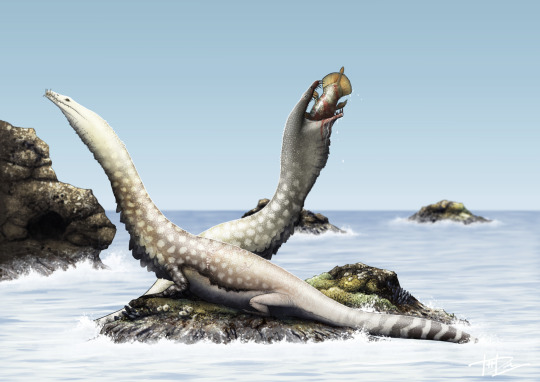
By Tas Dixon
Etymology: False Reptile
First Described By: Münster, 1834
Classification: Biota, Archaea, Proteoarchaeota, Asgardarchaeota, Eukaryota, Neokaryota, Scotokaryota, Opimoda, Podiata, Amorphea, Obazoa, Opisthokonta, Holozoa, Filozoa, Choanozoa, Animalia, Eumetazoa, Parahoxozoa, Bilateria, Nephrozoa, Deuterostomia, Chordata, Olfactores, Vertebrata, Craniata, Gnathostomata, Eugnathostomata, Osteichthyes, Sarcopterygii, Rhipidistia, Tetrapodomorpha, Eotetrapodiformes, Elpistostegalia, Stegocephalia, Tetrapoda, Reptiliomorpha, Amniota, Sauropsida, Eureptilia, Romeriida, Diapsida, Neodiapsida, Sauria, Archosauromorpha?, Archelosauria, Pantestudines, Sauropterygia, Eosauropterygia, Nothosauria, Nothosauridae, Nothosaurinae
Referred Species: N. mirabilis, N. cristatus, N. cymatosauroides, N. edingerae, N. giganteus, N. haasi, N. jagisteus, N. marchicus, N. mirabilis, N. tchernovi, N. yangjuanensis, N. zhangi
Time and Place: From 242 million years ago until 208 million years ago, from the Ladinian of the Middle Triassic through the earliest Rhaetian of the Late Triassic
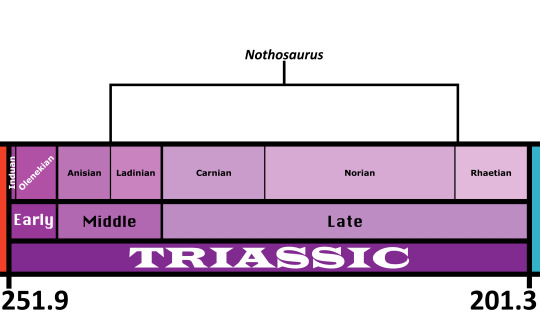
Nothosaurus is known from all over Eurasia and North Africa, to the point that it’s pointless to list all the locations. Just assume that if it’s the Mid or Late Triassic of the Tethys Sea, Nothosaurus is there.

Physical Description: Nothosaurus is an iconic Triassic marine reptile - to the point that we had to include it, or else we would have violated some sort of rule of paleontology. Nothosaurus was about 4 meters long on average, but could reach up to 7 meters in length. It had a long, streamlined body, with a long neck and a long tail. Its head was narrow and filled with long and pointed teeth which interlocked together when the mouth closed, forming a tight trap. Its forelimbs were longer than its hind limbs, and all of its hands and feet had webbing between the long toes. In a lot of ways, it looked extremely similar to later marine reptiles to which it was closely related, like the Plesiosaurs and Pliosaurs, just with hands instead of proper flippers - however, current evidence indicates that the Plesiosaurs and Pliosaurs evolved from an ancestor of both groups, and Nothosaurus is just a Triassic offshoot. It had capabilities for diving in the water, though it also was still adapted for life on the shore.
Diet: Nothosaurus primarily ate fish and other marine animals, including other marine reptiles.
Behavior: Nothosaurus was semi-aquatic, spending a lot of its time both in the ocean and on land. On the beaches and shores it would rest and sleep, and then turn to the ocean for most of its everyday life. Diving for food would have been most of its daily activities, going after juvenile reptiles and large fish in the water and diving in order to reach it. It probably would have paddled with its webbed feet, and undulated its body to some extent to help propel forward. It may have been at least somewhat social, living in groups and colonizing the shores together before going for group dives for food. Interestingly enough, Nothosaurus was basically like a reptilian seal, coming up to shore to rest and sit with its relatives. Whether or not they would have given birth to live young is uncertain; while their close relatives, the Plesiosaurs, did; they retained enough land adaptations to allow them to lay eggs on the shore. More research as to their physiology is needed in order to determine that aspect of their life history. Trackways have been attributed to Nothosaurus, which may show that they rowed their paddles on the sea bed to shake up small animals trapped underneath; this would have allowed Nothosaurus to capture the invertebrates between its long teeth and hold onto them so they could not escape.
Ecosystem: Nothosaurus lived throughout the early Tethys sea, and was a common feature in many communities throughout this growing body of water during the Middle and Late Triassic. It would have stuck to the coasts for the most part, but still ventured out into deep and open water. As such, it’s rather difficult to list all the different animals it lived alongside - it’s found in Bulgaria, China, France, Germany, Hungary, Israel, Italy, Jordan, the Netherlands, Poland, Saudi Arabia, Spain, and Switzerland. So just, assume that a marine creature from the Tethys during this time lived with Nothosaurus rather than not.
Other: Nothosaurus has been treated as, unfortunately, a wastebasket taxon - it was discovered early enough in the history of paleontology as a science that many similar animals were just dumped into this name without any specific studies done. So, determining the factual relationships from this mess is still being worked out; in fact, it seems that this genus is paraphyletic, with many close relatives of Nothosaurus being more closely related to some species than to others. So that’s fun!
Species Differences: The varying species of Nothosaurus tend to differ based on where and when they lived, rather than any particularly notable differences. There are some differences in size and limb proportions as well, but in general the differing species of Nothosaurus would have had very similar ecological roles.
~ By Meig Dickson
Sources Under the Cut
Albers, P. C. H., and O. Rieppel. 2003. A new species of the sauropterygian genus Nothosaurus from the Lower Muschelkalk of Winterswijk, The Netherlands. Journal of Paleontology 77(4):738-744.
Albers, P. C. H. 2005. A new specimen of Nothosaurus marchicus with features that relate the taxon to Nothosaurus winterswijkensis. Vertebrate Palaeontology 3 (1): 1- 7.
Brotzen, F. 1956. Stratigraphical studies on the Triassic vertebrate fossils from Wadi Raman, Israel. Arkiv foer Mineralogi och Geologi 2(9):191-217.
Chrzastek, A. 2008. Vertebrate remains from the Lower Muschelkalk of Raciborowice Górne (North-Sudetic Basin, SW Poland). Geological Quarterly 52:225-238.
Diedrich, C. 2009. The vertebrates of the Anisian/Ladinian boundary (Middle Triassic) from Bissendorf (NW Germany) and their contribution to the anatomy, palaeoecology, and palaeobiogeography of the Germanic Basin reptiles. Palaeogeography, Palaeoclimatology, Palaeoecology 273 (1): 1 - 16.
d'Orbigny, A. 1849. Cours Élémentaire de Paléontologie et de Géologie Stratigraphiques [Elementary Course in Paleontology and Stratigraphic Geology] 1:1-299.
Haas, G 1980. Ein Nothosaurier-Schädel aus dem Muschelkalk des Wadi Ramon (Negev, Israel). Annalen des Naturhistorischen Museums in Wien 83:119-125.
Haines, Tim, and Paul Chambers. The Complete Guide to Prehistoric Life. Pg. 64. Canada: Firefly Books Ltd., 2006
Hinz, J. K., A. T. Matzke, and H.-U. Pfretzschner. 2019. A new nothosaur (Sauropterygia) from the Ladinian of Vellberg-Eschenau, southern Germany. Journal of Vertebrate Paleontology.
Jiang, W.; Maisch, M. W.; Hao, W.; Sun, Y.; Sun, Z. 2006. Nothosaurus yangjuanensis n. sp. (Reptilia, Sauropterygia, Nothosauridae) from the middle Anisian (Middle Triassic) of Guizhou, southwestern China. Neues Jahrbuch für Geologie und Paläontologie, Monatshefte. 5: 257–276.
Jiang, D.-Y., L. Schmitz, R. Motani, W.-C. Hao, and Y.-L. Sun. 2007. The mixosaurid ichthyosaur Phalarodon cf. P. fraasi from the Middle Triassic of Guizhou Province, China. Journal of Paleontology 81(3):602-605.
Klein, N. and P. C. H. Albers. 2009. A new species of the sauropsid reptile Nothosaurus from the Lower Muschelkalk of the western Germanic Basin, Winterswijk, The Netherlands. Acta Palaeontologica Polonica 54(4):589-598.
Lin, W.-B.; Jiang, D.-Y.; Rieppel, O.; Motani, R.; Ji, C.; Tintori, A.; Sun, Z.-Y.; Zhou, Min 2017. A new specimen of Lariosaurus xingyiensis (Reptilia, Sauropterygia) from the Ladinian (Middle Triassic) Zhuganpo Member, Falang Formation, Guizhou, China. Journal of Vertebrate Paleontology 37 (2): e1278703.
Liu, J. 2014. A gigantic nothosaur (Reptilia: Sauropterygia) from the Middle Triassic of SW China and its implications for the Triassic biotic recovery. Scientific Reports 4: 7142.
Lu, H., D.-Y. Jiang, R. Motani, P.-G. Ni, Z.-Y. Sun, A. Tintori, S.-Z. Xiao, M. Zhou, C. Ji and W.-F. Fu. 2018. Middle Triassic Xingyi Fauna: Showing turnover of marine reptiles from coastal to oceanic environments. Palaeoworld 27(1):107-116.
Münster, G. G. 1834. Preliminary news about some new reptiles in the shell limestone of Baiern. New Yearbook for Mineralogy, Geognosy, Geology and Petriology 1834 : 521-527.
Palmer, D. ed. 1999. The Marshall Illustrated Encyclopedia of Dinosaurs and Prehistoric Animals. London: Marshall Editions. p. 72.
Rieppel, O., and J.-M. Mazin. 1997. Speciation along rifting continental margins: a new nothosaur from the Negev (Israel). Comptes rendus de l'Académie des Sciences Série IIA, Sciences de la Terre et des planètes 326:991-997.
Rieppel, O. 2001. A new species of Nothosaurus (Reptilia: Sauropterygia) from the Upper Muschelkalk (Lower Ladinian) of southwestern Germany. Palaeontographica Abteilung A 263:137-161.
Sepkoski, J. J. 2002. A compendium of fossil marine animal genera. Bulletins of American Paleontology 363:1-560.
#nothosaurus#nothosaur#sauropterygian#triassic#triassic madness#triassic march madness#prehistoric life#paleontology
302 notes
·
View notes
Text
Mantis Shrimp Robot: the references
https://www.pnas.org/content/118/33/e2026833118
Many small organisms produce ultrafast movements by storing elastic energy and mediating its storage and rapid release through a latching mechanism. The mantis shrimp in particular imparts extreme accelerations on rotating appendages to strike their prey. Biologists have hypothesized, but not tested, that there exists a geometric latching mechanism which mediates the actuation of the appendage. Inspired by the anatomy of the mantis shrimp striking appendage, we develop a centimeter-scale robot which emulates the linkage dynamics in the mantis shrimp and study how the underlying geometric latch is able to control rapid striking motions. Our physical and analytical models could also be extended to other behaviors such as throwing or jumping in which high power over short duration is required.
References
W. Gronenberg, Fast actions in small animals: Springs and click mechanisms. J. Comp. Physiol. A Neuroethol. Sens. Neural Behav. Physiol. 178, 727–734 (1996).CrossRefGoogle Scholar
A. Galantis, R. C. Woledge, The theoretical limits to the power output of a muscle-tendon complex with inertial and gravitational loads. Proc. Biol. Sci. 270, 1493–1498 (2003).CrossRefPubMedGoogle Scholar
S. N. Patek, D. M. Dudek, M. V. Rosario, From bouncy legs to poisoned arrows: Elastic movements in invertebrates. J. Exp. Biol. 214, 1973–1980 (2011).Abstract/FREE Full TextGoogle Scholar
M. Mark Ilton et al., The principles of cascading power limits in small, fast biological and engineered systems. Science 360, eaao1082 (2018).Google Scholar
S. J. Longo et al., Beyond power amplification: Latch-mediated spring actuation is an emerging framework for the study of diverse elastic systems. J. Exp. Biol. 222, 1–10 (2019).CrossRefGoogle Scholar
S. Vogel, Living in a physical world II. The bio-ballistics of small projectiles. J. Biosci. 30, 167–175 (2005).CrossRefPubMedGoogle Scholar
S. Vogel, Living in a physical world III. Getting up to speed. J. Biosci. 30, 303–312 (2005).CrossRefPubMedGoogle Scholar
A. Sakes et al., Shooting mechanisms in nature: A systematic review. PLoS One 11, e0158277 (2016).CrossRefPubMedGoogle Scholar
M. V. Rosario, G. P. Sutton, S. N. Patek, G. S. Sawicki, Muscle–spring dynamics in time-limited, elastic movements. Proc. R. Soc. B: Biol. Sci., 283, 20161561 (2016).CrossRefPubMedGoogle Scholar
S. M. Mark Ilton et al., The effect of size-scale on the kinematics of elastic energy release. Soft Matter 15, 9579–9586 (2019).Google Scholar
P. Gregory et al., Why do large animals never actuate their jumps with latch-mediated springs? Because they can jump higher without them. Integr. Comp. Biol. 59, 1609–1618 (2019).Google Scholar
O. Bolmin et al., Latching of the click beetle (Coleoptera: Elateridae) thoracic hinge enabled by the morphology and mechanics of conformal structures. J. Exp. Biol. 222, jeb196683 (2019).Abstract/FREE Full TextGoogle Scholar
S. Divi, X. Ma et al., Latch-based control of energy output in spring actuated systems. J. R. Soc. Interface 17, 20200070 (2020).Google Scholar
B. Webb, Using robots to model animals: A cricket test. Robot. Auton. Syst. 16, 117–134 (1995).CrossRefGoogle Scholar
K. Dianna et al., Addressing grand challenges in organismal biology: The need for synthesis. Bioscience 64, 1178–1187 (2014).CrossRefGoogle Scholar
D. L. Hu, M. Prakash, B. Chan, J. W. M. Bush, Water-walking devices. Exp. Fluids 43, 769–778 (2007).CrossRefGoogle Scholar
R. Altendorfer et al., Rhex: A biologically inspired hexapod runner. Auton. Robots 11, 207–213 (2001).CrossRefGoogle Scholar
F. Berlinger, J. Dusek, M. Gauci, R. Nagpal, Robust maneuverability of a miniature, low-cost underwater robot using multiple fin actuation. IEEE Robot. Autom. Lett. 3, 140–147 (2017).Google Scholar
M. J. McHenry et al., The comparative hydrodynamics of rapid rotation by predatory appendages. J. Exp. Biol. 219, 3399–3411 (2016).Abstract/FREE Full TextGoogle Scholar
S. N. Patek, W. L. Korff, R. L. Caldwell, Biomechanics: Deadly strike mechanism of a mantis shrimp. Nature 428, 819–820 (2004).CrossRefPubMedGoogle Scholar
S. N. Patek, R. L. Caldwell, Extreme impact and cavitation forces of a biological hammer: Strike forces of the peacock mantis shrimp Odontodactylus scyllarus. J. Exp. Biol. 208, 3655–3664 (2005).Abstract/FREE Full TextGoogle Scholar
R. L. Crane, S. M. Cox, S. A. Kisare, S. N. Patek, Smashing mantis shrimp strategically impact shells. J. Exp. Biol. 221, jeb176099 (2018).Abstract/FREE Full TextGoogle Scholar
T. I. Zack, T. Claverie, S. N. Patek, Elastic energy storage in the mantis shrimp’s fast predatory strike. J. Exp. Biol. 212, 4002–4009 (2009).Abstract/FREE Full TextGoogle Scholar
S. N. Patek, M. V. Rosario, J. R. A. Taylor, Comparative spring mechanics in mantis shrimp. J. Exp. Biol. 216, 1317–1329 (2013).Abstract/FREE Full TextGoogle Scholar
M. V. Rosario, S. N. Patek, Multilevel analysis of elastic morphology: The mantis shrimp’s spring. J. Morphol. 276, 1123–1135 (2015).CrossRefPubMedGoogle Scholar
M. Tadayon, S. Amini, A. Masic, A. Miserez, The mantis shrimp saddle: A biological spring combining stiffness and flexibility. Adv. Funct. Mater. 25, 6437–6447 (2015).CrossRefGoogle Scholar
M. Tadayon, S. Amini, Z. Wang, A. Miserez, Biomechanical design of the mantis shrimp saddle: A biomineralized spring used for rapid raptorial strikes. iScience 8, 271–282 (2018).Google Scholar
S. N. Patek, B. N. Nowroozi, J. E. Baio, R. L. Caldwell, A. P. Summers, Linkage mechanics and power amplification of the mantis shrimp’s strike. J. Exp. Biol. 210, 3677–3688 (2007).Abstract/FREE Full TextGoogle Scholar
M. J. McHenry, T. Claverie, M. V. Rosario, S. N. Patek, Gearing for speed slows the predatory strike of a mantis shrimp. J. Exp. Biol. 215, 1231–1245 (2012).Abstract/FREE Full TextGoogle Scholar
M. Burrows, The mechanics and neural control of the prey capture strike in the mantid shrimps squilla and hemisquilla. Z. Vgl. Physiol. 62, 361–381 (1969).CrossRefGoogle Scholar
M. Burrows, G. Hoyle, Neuromuscular physiology of the strike mechanism of the mantis shrimp, hemisquilla. J. Exp. Zool. 179, 379–393 (1972).CrossRefGoogle Scholar
M. S. deVries, E. A. K. Murphy, S. N. Patek, Strike mechanics of an ambush predator: The spearing mantis shrimp. J. Exp. Biol. 215, 4374–4384 (2012).Abstract/FREE Full TextGoogle Scholar
K. Kagaya, S. N. Patek, Feed-forward motor control of ultrafast, ballistic movements. J. Exp. Biol. 219, 319–333 (2016).Abstract/FREE Full TextGoogle Scholar
S. N. Patek, The power of mantis shrimp strikes: Interdisciplinary impacts of an extreme cascade of energy release. Integr. Comp. Biol. 59, 1573–1585 (2019).CrossRefGoogle Scholar
S. M. Cox, D. Schmidt, Y. Modarres-Sadeghi, S. N. Patek, A physical model of the extreme mantis shrimp strike: Kinematics and cavitation of Ninjabot. Bioinspir. Biomim. 9, 016014 (2014).CrossRefPubMedGoogle Scholar
S. J. Longo, T. Goodearly, P. C. Wainwright. Extremely fast feeding strikes are powered by elastic recoil in a seahorse relative, the snipefish, Macroramphosus scolopax. Proc. R. Soc. B: Biol. Sci. 285, 20181078 (2018).CrossRefPubMedGoogle Scholar
D. Cofer, G. Cymbalyuk, W. J. Heitler, D. H. Edwards, Neuromechanical simulation of the locust jump. J. Exp. Biol. 213, 1060–1068 (2010).Abstract/FREE Full TextGoogle Scholar
T. Kaji, A. Anker, C. S. Wirkner, A. R. Palmer, Parallel saltational evolution of ultrafast movements in snapping shrimp claws. Curr. Biol. 28, 106–113.e4 (2018).CrossRefGoogle Scholar
S. N. Patek, S. J. Longo, Evolutionary biomechanics: The pathway to power in snapping shrimp. Curr. Biol. 28, R115–R117 (2018).CrossRefGoogle Scholar
J. A. C. Knowles, M. H. Lowenberg, S. A. Neild, B. Krauskopf, A bifurcation study to guide the design of a landing gear with a combined uplock/downlock mechanism. Proc. R. Soc. Math. Phys. Eng. Sci. 470, 20140332 (2014).Google Scholar
J. A. C. Knowles, B. Krauskopf, M. H. Lowenberg, Numerical continuation applied to landing gear mechanism analysis. J. Aircr. 48, 1254–1262 (2011).CrossRefGoogle Scholar
H. C. Bennet-Clark, E. C. A. Lucey, The jump of the flea: A study of the energetics and a model of the mechanism. J. Exp. Biol. 47, 59–67 (1967).Abstract/FREE Full TextGoogle Scholar
M. Noh, S.-W. Kim, S. An, J.-S. Koh, K.-J. Cho, Flea-inspired catapult mechanism for miniature jumping robots. IEEE Trans. Robot. 28, 1007–1018 (2012).Google Scholar
J.-S. Koh et al., Jumping on water: Surface tension–dominated jumping of water striders and robotic insects. Science 349, 517–521 (2015).Abstract/FREE Full TextGoogle Scholar
J.-S. Koh, J. Sun-pil, R. J. Wood, K.-J. Cho. “A jumping robotic insect based on a torque reversal catapult mechanism” in 2013 IEEE/RSJ International Conference on Intelligent Robots and Systems (IEEE, 2013), pp. 3796–3801.Google Scholar
P. S. L. Anderson, T. Claverie, S. N. Patek, Levers and linkages: Mechanical trade-offs in a power-amplified system. Evolution 68, 1919–1933 (2014).CrossRefPubMedGoogle Scholar
P. S. L. Anderson, S. N. Patek, Mechanical sensitivity reveals evolutionary dynamics of mechanical systems. Proc. R. Soc. B: Biol. Sci. 282, 20143088 (2015).CrossRefPubMedGoogle Scholar
Y. Hu, N. Nelson-Maney, P. S. L. Anderson, Common evolutionary trends underlie the four-bar linkage systems of sunfish and mantis shrimp. Evolution 71, 1397–1405 (2017).Google Scholar
M. M. Munoz, P. S. L. Anderson, S. N. Patek, Mechanical sensitivity and the dynamics of evolutionary rate shifts in biomechanical systems. Proc. R. Soc. B: Biol. Sci., 284, 20162325 (2017).CrossRefPubMedGoogle Scholar
M. Muller, Optimization principles applied to the mechanism of neurocranium levation and mouth bottom depression in bony fishes (halecostomi). J. Theor. Biol. 126, 343–368 (1987).CrossRefGoogle Scholar
M. W. Westneat, Feeding mechanics of teleost fishes (Labridae; Perciformes): A test of four-bar linkage models. J. Morphol. 205, 269–295 (1990).CrossRefGoogle Scholar
M. W. Westneat, Transmission of force and velocity in the feeding mechanisms of labrid fishes (teleostei, perciformes). Zoomorphology 114, 103–118 (1994).CrossRefGoogle Scholar
M. Burrows, O. Morris, Jumping and kicking in bush crickets. J. Exp. Biol. 206, 1035–1049 (2003).Abstract/FREE Full TextGoogle Scholar
T. J. Roberts, E. Azizi, Flexible mechanisms: The diverse roles of biological springs in vertebrate movement. J. Exp. Biol. 214, 353–361 (2011).Abstract/FREE Full TextGoogle Scholar
R. M. Murray, Z. Li, S. Sastry, A Mathematical Introduction to Robotic Manipulation (CRC Press, 2017).Google Scholar
J. P. Whitney, P. S. Sreetharan, K. Y. Ma, R. J. Wood, Pop-up book mems. J. Micromech. Microeng. 21, 115021 (2011).CrossRefPubMedGoogle Scholar
P. S. Sreetharan, J. P. Whitney, M. D. Strauss, R. J. Wood, Monolithic fabrication of millimeter-scale machines. J. Micromech. Microeng. 22, 055027 (2012).CrossRefGoogle Scholar
J. M. Birch, M. H. Dickinson, Spanwise flow and the attachment of the leading-edge vortex on insect wings. Nature 412, 729–733 (2001).CrossRefPubMedGoogle Scholar
C. Li, S. T. Hsieh, D. I. Goldman, Multi-functional foot use during running in the zebra-tailed lizard (Callisaurus draconoides). J. Exp. Biol. 215, 3293–3308 (2012).Abstract/FREE Full TextGoogle Scholar
D. P. Holmes, A. J. Crosby, Snapping surfaces. Adv. Mater. 19, 3589–3593 (2007).Google Scholar
H. C. Astley, T. J. Roberts, Evidence for a vertebrate catapult: Elastic energy storage in the plantaris tendon during frog jumping. Biol. Lett. 8, 386–389 (2012).CrossRefPubMedGoogle Scholar
H. C. Astley, T. J. Roberts, The mechanics of elastic loading and recoil in anuran jumping. J. Exp. Biol. 217, 4372–4378 (2014).Abstract/FREE Full TextGoogle Scholar
F. J. Larabee, A. V. Suarez, The evolution and functional morphology of trap-jaw ants (hymenoptera: Formicidae). Myrmecol. News 20, 25–36 (2014).Google Scholar
R. Ritzmann, Snapping behavior of the shrimp Alpheus californiensis. Science 181, 459–460 (1973).Abstract/FREE Full TextGoogle Scholar
E. R. Ritzmann, Mechanisms for the snapping behavior of two alpheid shrimp, Alpheus californiensis and Alpheus heterochelis. J. Comp. Physiol. 95, 217–236 (1974).Google Scholar
A. M. Olsen, A mobility-based classification of closed kinematic chains in biomechanics and implications for motor control. J. Exp. Biol. 222, jeb195735 (2019).Abstract/FREE Full TextGoogle Scholar
A. M. Olsen, A. L. Camp, E. L. Brainerd, The opercular mouth-opening mechanism of largemouth bass functions as a 3d four-bar linkage with three degrees of freedom. J. Exp. Biol. 220, 4612–4623 (2017).Abstract/FREE Full TextGoogle Scholar
N. J. Cowan et al., Feedback control as a framework for understanding tradeoffs in biology. Integr. Comp. Biol. 54, 223–237 (2014).CrossRefPubMedGoogle Scholar
J.-S. Koh, S.-P. Jung, M. Noh, S.-W. Kim, K.-J. Cho, “Flea inspired catapult mechanism with active energy storage and release for small scale jumping robot ” in 2013 IEEE International Conference on Robotics and Automation (IEEE, 2013), pp. 26–31.Google Scholar
G. P. Sutton, M. Burrows, Biomechanics of jumping in the flea. J. Exp. Biol. 214, 836–847 (2011).Abstract/FREE Full TextGoogle Scholar
T. Ayling, Guide to the Sea Fishes of New Zealand (William Collins Publishers Ltd, Auckland, New Zealand, 1982).Google Scholar
P. A. Green, S. N. Patek, Contests with deadly weapons: Telson sparring in mantis shrimp (Stomatopoda). Biol. Lett. 11, 20150558 (2015).CrossRefPubMedGoogle Scholar
2 notes
·
View notes
Note
Any other rants today? 💕💕💕
it is 7:30 in the gotdam morning and NO i have not slept but on my mf mind is simple,,, the Tragedy that is petekey
it's a common subject on this blog ofc but when I rly get to like... thinking abt it? it's so nuts. like pete was really truly on god so deeply in love w mikey, deep enough that he's Still pulling words from 15 yr old lj posts for his music today. that's some mf Commitment to ur sadness...
anyway i also like to think about how happy they were together got those brief weeks in the beginning of warped 2005,,,we all know that it crashed in burned but I think for a moment there they lived in their own little world, and to me? that's p beautiful. maybe id still write abt it a decade later too
11 notes
·
View notes
Text
FAITH
It feels so surreal that I am now writing my own blog and formally publishing it to the public and letting someone read it. I have my own personal journal which only I can see and read, but I have always wanted to try this and experience interaction with readers I am not familiar with or just simply sharing it to the public.
I have attended leadership training so many times before when I was in secondary school and in college. Back then, we used to take a two day school trip where all the club’s executive officers and the Student Council officers would gather, learn, and perform group activities related to concepts about leadership. Having been enrolled in Catholic schools all my life, these training also involved the teaching of values and virtues that God and our patron saints have applied when they’re building their legacies.
I remember I always heard the topic of the difference between a “manager” and a “leader”. Some of the most common comparisons of these two are that leaders are visionary, while managers are goal-oriented, leaders are change agents, while managers are traditional, and leaders think long term, whereas managers consider short term. My favorites are; leaders lead, while managers manage, leaders build relationships, whereas managers build processes, and leaders influence, while managers control. These three are the comparisons between a leader and a manager that stood out to me the most: I want to be a leader. That is why it inspires me how our patron saint, St. John Baptist de lasalle, embodied how it is to be a servant-leader. According to Larry Spears, “Servant leadership emphasizes increased service to others, a holistic approach to work, promoting a sense of community, and the sharing of power in decision making.” (Spears, 2005, p. 2). St. John Baptist de lasalle abandoned all his wealth and chose a path of being a servant first through initiating a free school for poor boys in Reims, France. He also took in the struggling teachers to his home, and eventually used his own wealth to feed the poor during the period of famine. He then built his own school with the vision of teaching poor boys for free and sharing the words of God with them. St. John is a visionary. He leads people and sets an example by living with a vow of poverty and by doing the actions himself. He empathized, built a community, and had a commitment to its growth. His life has established the virtues of a Lasallian leader which all of us Lasallians should, or at least try, to embody. This has formed as guiding principles to the community he has built - faith, zeal, and communion.
After learning these, it made me ask myself, what are my guiding principles in life? Do I even have at least one? After a thorough reflection, “faith” has come into my mind. Similar to St. John the Baptist de lasalle, I have faith in God. I cannot say that it is unwavering, but I have to admit it has been tested so many times, especially when something unfortunate is going on in my life and I feel hopeless. Having faith and relying on Him make me feel even more hopeless. Sometimes I think, I should not rely on God when I feel down or if I am going through something. I should only go to Him when everything is fine. Weird, right? But I honestly feel that way, sometimes. However, God always finds His way back to me as I also find myself turning to Him, again. We are like positive and negative magnets. No matter how I try to repel, I always end up holding on to Him. I also apply the virtue of being “reserve” especially at the workplace. Tragic life in a corporate world requires one whole journal, but I know you know how it is. However, for instance that my patience and temperament is being tested, I always choose to keep my respect and be reserved in those situations; even if the person is not doing the same to me. You know the golden rule in the bible of “Do not do unto others what you do not want others to do unto you?” (Matthew 7:12). It is truly a great commandment, but is hard to apply especially when even if you don’t do that to others, others are still doing those to you. In these scenarios, my faith and reserve virtues are always being tested. I thank God for helping me to keep these in check.
I wonder how St. John Baptist de lasalle kept his guiding principles? How do you keep your guiding principles?
Aruda, W. (2016, Nov. 15) Differences between a leader and a manager. Forbes.https://www.forbes.com/sites/williamarruda/2016/11/15/9-differences-between-being-a-leader-and-a-manager/?sh=13c471f04609
La Salle Organization (n.d.) John Baptist de La Salle: His Life and Times. La Salle Organization. http://revista_roma.delasalle.edu.mx/numero_7/alphonse_leblanc7.pdf
1 note
·
View note
Text
Diabloceratops eatoni
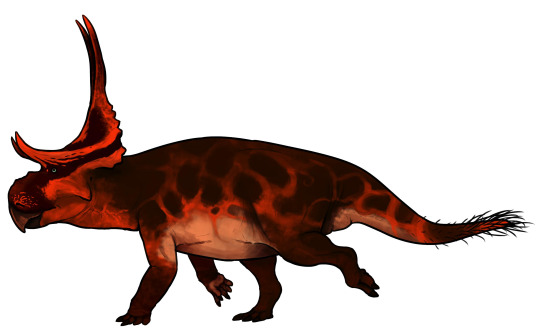
By Jack Wood
Etymology: Devil Horned Face
First Described By: Kirkland et al., 2010
Classification: Dinosauromorpha, Dinosauriformes, Dracohors, Dinosauria, Ornithischia, Genasauria, Neornithischia, Cerapoda, Marginocephalia, Ceratopsia, Neoceratopsia, Coronosauria, Ceratopsoidea, Ceratopsidae, Centrosaurinae?
Status: Extinct
Time and Place: Between 81 and 79 million years ago, in the Campanian of the Late Cretaceous


Diabloceratops is known from the lower and middle members of the Wahweap Formation of Utah

Physical Description: Diabloceratops is one of the most completely visually distinctive Ceratopsids - like all members of this very samey group, its body was the same as the rest of them, but its head was distinctive enough to give it a famous name. Like other Ceratopsids, Diabloceratops had four squat legs, a thick torso, and a short tail. It had a long head, with a large crest and a giant beak in the front of its snout, as well as teeth well built for chewing. The interesting thing about this Ceratopsid is that, while it has small brow horns like most early members of this group, it also had two very noticeable horns coming out of its frills - curving away from each other, the left one curving out to the left and the right one curving out to the right. This gave Diabloceratops the very distinctive look of… well, the Christian depiction of Satan. Hence its name, Devil Horned Face! It had a lightly built skull, with a hole seen in earlier Ceratopsians than the later Ceratopsids, and its head was shorter and deeper than later members. The frill of Diabloceratops was kind of weird too - very tall and narrow, rather than wider as in later Ceratopsians. Diabloceratops was primarily scaly all over, though it is possible (especially given how early derived it was) that it had quills or feathery fluff on its tail like earlier Ceratopsians. It was probably about 5.5 meters long from head to tail.

By Nix, CC BY-NC 4.0
Diet: As a Ceratopsid, Diabloceratops probably fed primarily on plants, though it is possible that it supplemented its diet with meat from time to time for protein. It would focus on low-lying and medium-level plant material, less than a meter in height.
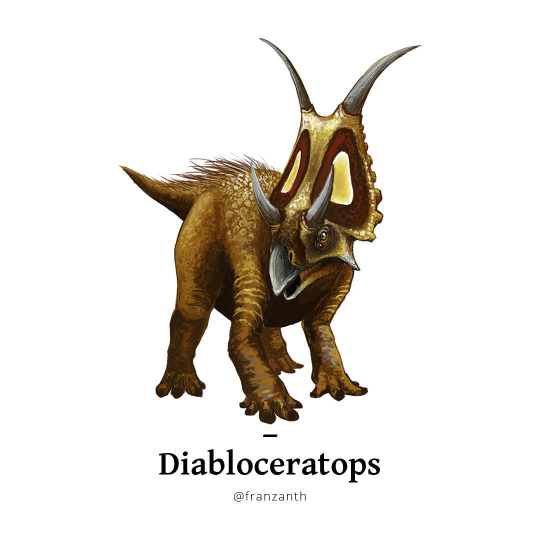
By Franz Anthony
Behavior: The frill and fancy spikes of Diabloceratops would have been primarily used in sexual display and other types of communication between members of the herd, especially since they were rather small all things considered. That being said, other Ceratopsians would use these features for defense, and it is thus likely that Diabloceratops did too, even though they didn’t evolve for such a purpose. Diabloceratops, like other Ceratopsians, would have been a very social animal, spending most of its life in herds with socially complex behavior. These herds would have aided Diabloceratops in defending itself from the local predator Lythronax, and any other predatory animals that may have attempted to attack it. Like other dinosaurs, Diabloceratops probably would have taken care of its young, and the social group would have aided it in doing so. Being a large herbivore with deadly weapons on its face, Diabloceratops would have been a very aggressive animal, not trusting anything that got too close to it or its family. It is possible that Diabloceratops herds also migrated too and from the Western Interior Seaway, based on the seasonal rainfall.

By Sam Stanton
Ecosystem: The Wahweap Formation is one of the earliest environments we know of from the charismatic and iconic Late Cretaceous North American faunas - those ecosystems from the Campanian and Maastrichtian which featured Ceratopsians, Hadrosaurs, and Ankylosaurs a plenty, all being preyed upon by terrifying Tyrannosaurs. Weirdly enough, this unique makeup of these ecosystems is unique to North America - while Hadrosaurs could be found elsewhere somewhat, both Tyrannosaurs and Ceratopsids were very rare elsewhere, Ceratopsids especially so. Instead, the world was frequented with many other kinds of large predatory dinosaurs (especially Abelisaurids), and Titanosaurs were some of the most common large herbivores. But I am getting off track - the Wahweap Formation is one of the earliest of these charismatic locations, and as expected, it has some of the earliest members of these groups to branch off, including Diabloceratops. The Wahweap Formation began as a very dry ecosystem, filled with sand and very brief wet seasons; over time, it became a pond ecosystem and - by the time Diabloceratops disappeared - a very fertile system of rivers running in from the Western Interior Seaway.

By Nathan E. Rogers, used with permission from Studio 252Mya
So, in the time of the earliest part of the formation, Diabloceratops was a living in an extremely seasonally varied environment, as it began to transition to more freshwater being present in later millenia from its earlier dry beginnings. The diversity of the later environments, however, was lacking in the earliest one. Here, Diabloceratops was preyed upon by Lythronax, and while some mammals, turtles, and crocodylomorphs were present, it is entirely possible that the great diversity of mammals and other animals to be found later wasn’t present quite yet. In the middle environment, when the ponds were coming in and things were getting more lush, Lythronax was gone - but now Diabloceratops was accompanied by the Hadrosaur Acristavus, similar to the later Maiasaura. There were many non-dinosaurs too, like turtles, though it is uncertain if the many mammals found in Wahweap are from the middle, lower, or upper parts of this environment.
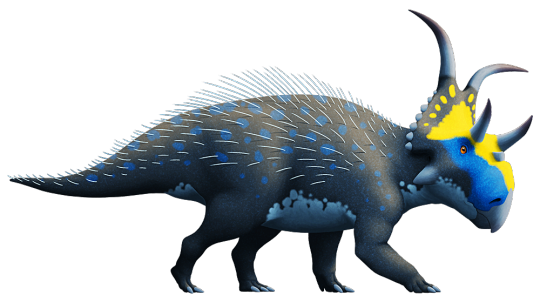
By Nix, CC BY-NC 4.0
Interestingly enough, one of Diabloceratops’ closest relatives, Machairoceratops, is known from the upper unit of this formation - indicating that it is possible that Diabloceratops evolved into Machairoceratops, and never really disappeared from the environment at all.
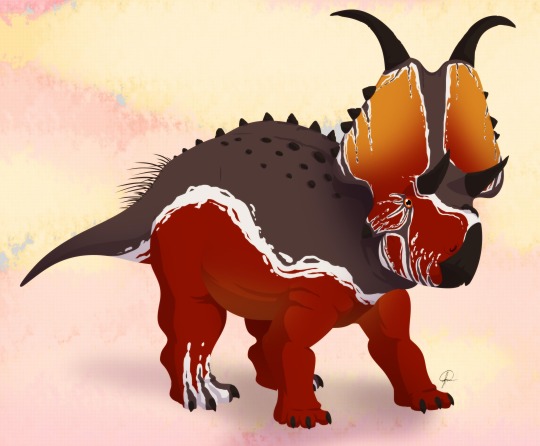
By José Carlos Cortés
Other: Diabloceratops is usually found to be a Centrosaurine, the group of Ceratopsids with prominent nose horns and frill ornamentation, and usually little to no brow horns. However, a very recent analysis of Ceratopsian relationships found Diabloceratops to be neither a Centrosaurine nor a Chasmosarine (the other group of Ceratopsians, which includes Triceratops and its closest relatives), but rather outside both. Either way, Diabloceratops was a very early Ceratopsids, showing characteristics that are often found in common between both of the major groups of these dinosaurs - and showing how weird their headgear got even early on in their evolution.
~ By Meig Dickson
Sources Under the Cut
Chiba, K.; Michael J. Ryan; Federico Fanti; Mark A. Loewen; David C. Evans (2018). "New material and systematic re-evaluation of Medusaceratops lokii (Dinosauria, Ceratopsidae) from the Judith River Formation (Campanian, Montana)". Journal of Paleontology. in press (2): 272–288.
Dalman, Sebastian G.; Hodnett, John-Paul M.; Lichtig, Asher J.; Lucas, Spencer G. (2018). "A new ceratopsid dinosaur (Centrosaurinae: Nasutoceratopsini) from the Fort Crittenden Formation, Upper Cretaceous (Campanian) of Arizona". New Mexico Museum of Natural History and Science Bulletin. 79: 141–164.
De Blieux, Donald D. 2007. Analysis of Jim's hadrosaur site; a dinosaur site in the middle Campanian (Cretaceous) Wahweap Formation of Grand Staircase-Escalante National Monument (GSENM), southern Utah. Abstracts with Programs – Geological Society of America 39 (5): 6.
Eaton, J. G., R. L. Cifelli. 2005. Review of Cretaceous mammalian paleontology; Grand Staircase-Escalante National Monument, Utah. Abstracts with Programs - Geological Society of America 37 (7): 115.
Evans, D. C., and M. J. Ryan. 2015. Cranial anatomy of Wendiceratops pinhornensis gen. et sp. nov., a centrosaurine ceratopsid (Dinosauria: Ornithischia) from the Oldman Formation (Campanian), Alberta, Canada, and the evolution of ceratopsid nasal ornamentation. PLoS ONE 10(7):e0130007
Farke, A. A. 2011. Anatomy and taxonomic status of the chasmosaurine ceratopsid Nedoceratops hatcheri from the Upper Cretaceous Lance Formation of Wyoming, U.S.A. PLoS One 6(1(e16196)):1-9
Farke, A. A., M. J. Ryan, P. M. Barrett, D. H. Tanke, D. R. Braman, M. A. Loewen, and M. R. Graham. 2011. A new centrosaurine from the Late Cretaceous of Alberta, Canada, and the evolution of parietal ornamentation in horned dinosaurs. Acta Palaeontologica Polonica 56(4):691-702
Fiorillo, A. R., and R. S. Tykoski. 2012. A new Maastrichtian species of the centrosaurine ceratopsid Pachyrhinosaurus from the North Slope of Alaska. Acta Palaeontologica Polonica 57(3):561-573
Fowler, D. W. 2017. Revised geochronology, correlation, and dinosaur stratigraphic ranges of the Santonian-Maastrichtian (Late Cretaceous) formations of the Western Interior of North America. PLoS ONE 12 (11): e0188426.
Gates, T.A.; Horner, J.R.; Hanna, R.R.; Nelson, C.R. (2011). "New unadorned hadrosaurine hadrosaurid (Dinosauria, Ornithopoda) from the Campanian of North America". Journal of Vertebrate Paleontology. 31 (4): 798–811.
Gates, Jinnah, Levitt, and Getty, 2014. New hadrosaurid specimens from the lower-middle Campanian Wahweap Formation of southern Utah. pp. 156–173. In The Hadrosaurs: Proceedings of the International Hadrosaur Symposium (D. A. Eberth and D. C. Evans, eds), Indiana University Press, Bloomington.
Getty, M. A., M. A. Loewen, E. M. Roberts, A. L. Titus, and S. D. Sampson. 2010. Taphonomy of horned dinosaurs (Ornithischia: Ceratopsidae) from the late Campanian Kaiparowits Formation, Grand Staircase-Escalante National Monument, Utah. In M. J. Ryan, B. J. Chinnery-Allgeier, D. A. Eberth (eds.), New Perspectives on Horned Dinosaurs: The Royal Tyrrell Museum Ceratopsian Symposium. Indiana University Press, Bloomington 478-494
Hone, D.W.E.; Naish, D.; Cuthill, I.C. (2011). “Does mutual sexual selection explain the evolution of head crests in pterosaurs and dinosaurs?” (PDF). Lethaia. 45 (2): 139–156.
Glut, D. F., 2012, Dinosaurs, the Encyclopedia, Supplement 7: McFarland & Company, Inc, 866pp.
Kentaro Chiba; Michael J. Ryan; Federico Fanti; Mark A. Loewen; David C. Evans (2018). "New material and systematic re-evaluation of Medusaceratops lokii (Dinosauria, Ceratopsidae) from the Judith River Formation (Campanian, Montana)". Journal of Paleontology. in press (2): 272–288.
Kirkland, J. I. 2005. An inventory of paleontological resources in the lower Wahweap Formation (lower Campanian), southern Kaiparowits Plateau, Grand Staircase-Escalante National Monument, Utah. Abstracts with Programs - Geological Society of America 37 (7): 114.
Kirkland, J. I., and D. D. DeBlieux. 2007. New horned dinosaurs from the Wahweap Formation, Grand Staircase-Escalante National Monument, southern Utah. Utah Geological Survey Notes 39(3):4-5
Kirkland, J. I., and D. D. Deblieux. 2010. New basal centrosaurine ceratopsian skulls from the Wahweap Formation (middle Campanian), Grand Staircase-Escalante National Monument, southern Utah. New Perspectives on Horned Dinosaurs: The Royal Tyrrell Museum Ceratopsian Symposium. Indiana University Press, Bloomington 117-140
Loewen, M. A., R. B. Irmis, J. J. W. Sertich, P. J. Currie, and S. D. Sampson. 2013. Tyrant dinosaur evolution tracks the rise and fall of Late Cretaceous oceans. PLoS ONE 8(11):e79420
Lund, E. K., P. M. O'Connor, M. A. Loewen and Z. A. Jinnah. 2016. A new centrosaurine ceratopsid, Machairoceratops cronusi gen et sp. nov., from the Upper Sand Member of the Wahweap Formation (Middle Campanian), southern Utah. PLoS ONE 11(5):e0154403:1-21
Mallon, Jordan C; David C Evans; Michael J Ryan; Jason S Anderson (2013). [tp://link.springer.com/article/10.1186/1472-6785-13-14 “Feeding height stratification among the herbivorous dinosaurs from the Dinosaur Park Formation (upper Campanian) of Alberta, Canada”]. BMC Ecology. 13: 14.
Orsulak, M. 2007. A lungfish burrow in late Cretaceous upper capping sandstone member of the Wahweap Formation Cockscomb area, Grand Staircase-Escalante National Monument, Utah. Abstracts with Programs - Geological Society of America 39 (5): 43.
Sampson, S. D., 2001, Speculations on the socioecology of Ceratopsid dinosaurs (Orinthischia: Neoceratopsia): In: Mesozoic Vertebrate Life, edited by Tanke, D. H., and Carpenter, K., Indiana University Press, pp. 263–276.
Simpson, Edward L.; Hilbert-Wolf, Hannah L.; Wizevich, Michael C.; Tindall, Sarah E.; Fasinski, Ben R.; Storm, Lauren P.; Needle, Mattathias D. (2010). "Predatory digging behavior by dinosaurs". Geology. 38 (8): 699–702.
Tester, E. 2007. Isolated vertebrate tracks from the Upper Cretaceous capping sandstone member of the Wahweap Formation; Grand Staircase-Escalante National Monument, Utah. Abstracts with Programs - Geological Society of America 39 (5): 42.
Thompson, C. R. 2004. A preliminary report on biostratigraphy of Cretaceous freshwater rays, Wahweap Formation and John Henry Member of the Straight Cliffs Formation, southern Utah. Abstracts with Programs - Geological Society of America 36 (4): 91.
Weishampel, David B; et al. (2004). "Dinosaur distribution (Late Cretaceous, North America)." In: Weishampel, David B.; Dodson, Peter; and Osmólska, Halszka (eds.): The Dinosauria, 2nd, Berkeley: University of California Press. Pp. 574–588.
Williams, J. A. J., C. F. Lohrengel. 2007. Preliminary study of freshwater gastropods in the Wahweap Formation, Bryce Canyon National Park, Utah. Abstracts with Programs - Geological Society of America 39 (5): 43.
Zubair A. Jinnah, #30088 (2009)Sequence Stratigraphic Control from Alluvial Architecture of Upper Cretaceous Fluvial System - Wahweap Formation, Southern Utah, U.S.A. Search and Discovery Article #30088. Posted June 16, 2009.
#Diabloceratops eatoni#Diabloceratops#Dinosaur#Ceratopsian#Palaeoblr#Factfile#Ceratopsid#Mesozoic Monday#Herbivore#Cretaceous#North America#paleontology#prehistory#prehistoric life#dinosaurs#biology#a dinosaur a day#a-dinosaur-a-day#dinosaur of the day#dinosaur-of-the-day#science#nature
410 notes
·
View notes
Photo

Earl AKA #dmx My story: In 2005 I had a lifechanging experience as a teaching artist in #bedstuy working with kids who nobody cared about in middle school filled with children left behind most of whom were #kinship (raised by kin, fosterparents, grandparents, group homes etc.)Job 2 was at an alternative high school and I was blessed to be part of a program called Literature to Life where I shared the arts in the classroom to teach Richard Wright's #Blackboy including #hiphop Kids & I shared rap lyrics w each other. I taught them rappers were writers just like Richard. I paired Black Boy with Manchild In The Promised Land and other books including the autobiography of DMX. His book taught us about his early upbringing what a talented graphic artist he was at a young age, his connection to dogs.. We learned about his heart, how much he had in common with Richard and Claude. How the story of being a young Black male in America has a common thread despite the era. Same #systemicracism at his back, different clothes.. I shared this with my students mostly young Black men. I also taught metaphor: Hunger stood at my bedside.-Wright X was hunger. -Earl Simmons Earl was hungry for something that was insatiable.. Getting tricked into addiction at 14 became a tragic circumstance he never could quite overcome. He was still an artist, with lots of love in his heart, he was deeply spiritual and he shared himself and his struggles with the world. He was a truth teller and truth seeker. I hope that now that he's gone we will really take a serious look at addiction. Earl was not and is not the only one. Many have been lost to to not getting enough. Artists and non-artists alike. Like my alcoholic father, parents of dear dear friends, former students. The so called #warondrugs was another part of systemic racism and stereotyping. Black and Brown people did not bring crack or heroin into our communities. Drugs have destroyed families for decades. Earl was one of many. But the fact his kin was there for him at the end tells so much about the person he was. A loving yet tortured soul who succumbed to a hunger that never went away. God Bless this son of God. #earlsimmons https://www.instagram.com/p/CNfcEYqp9EY/?igshid=1k0kfevkzgasc
1 note
·
View note
Text
Cuttlefish --not so cuddly
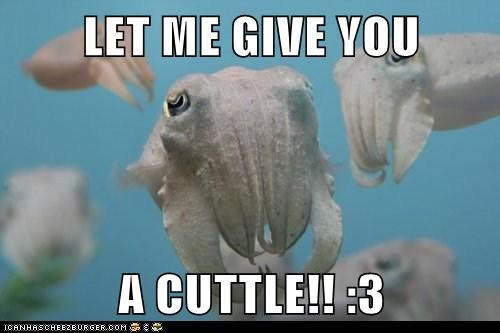
I. Classification
Animalia
Bilateria
Protosomia
Lophozoa
Mollusca
Cephalopoda
Coleoidea
Sepiida
Sepiidae
Sepia
officinalis
Integrated Taxonomic Information System, Sepia officinalis (Linnaeus, 1758)
II. Biology
Vagabond Lifestyle
The Sepia species can be found across temperate and tropical seas except off the coast of the Americas. A range of species can be found in Asia, Europe, Africa and Australia.
Each species of sepia live in either tropical or temperate waters. They are saltwater dependent so they all inhabit the ocean. They can either live in shallow or deeper waters (as low as 2,000 ft beneath the surface). Some species migrate from warm to colder temperature as the seasons change.
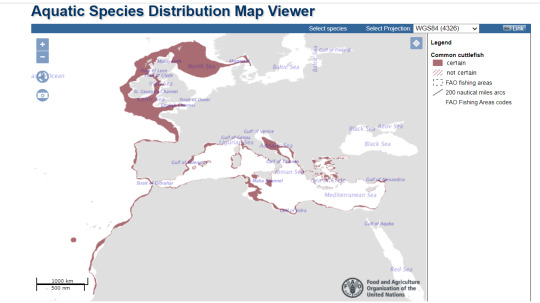
Image retrieved from fao.org
Armed and Dangerous
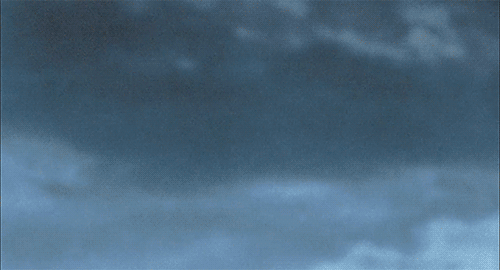
The Cuddlefish Cuttlefish has 8 arms along with 2 tentacles. These are specialized for holding on to prey like fish or shrimp. It lures prey by altering its skin color while waving its arms in a mesmerizing fashion to draw in unsuspecting prey. When the prey is near enough, its tentacles shoot forward and entangle the prey. The arms of the cuttlefish also has the ability to suck in water into its mantle cavity in order to appear larger when trying to ward off predators.
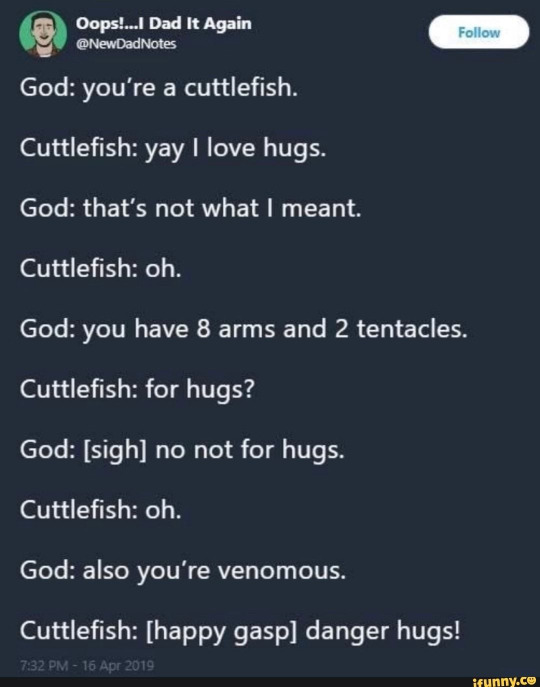
Beak
Much like a parrot’s beak, this is used to subdue prey or as a last defense towards predators. It lies deep in the base of the 8 arms of the cuttlefish. Beaks are one of the characteristics scientists use to identify species from each other.
Big Brain Energy

What makes this organism diverse may be attributed to the size of its brain. It is considered as one of the largest of any invertebrate. It can handle a variety of inputs from different senses like sight,smell and “sound” caused by pressure waves. Based on various studies, the cuttlefish can use visual cues in solving mazes. They are considered as intelligent as octopus and pigeons.
Cuttlebone

Image retrieved from: https://www.pbs.org/wgbh/nova/camo/anat-nf.html
Cuttlefish can control their buoyancy! Through their cuttlebone, a porous internal shell, they can adjust gas levels in the forward chamber and water level in the rear chamber, to control the buoyancy to rest in the water column.
Eye see you

Image retrieved from: https://www.pbs.org/wgbh/nova/camo/anat-nf.html
The cuttlefish is considered to have the most highly developed eyes in the animal kingdom. It is able to see in low light and can detect polarized light. While humans only reshape lenses to see, these organisms reshape their whole eye. It has a “w” shape on the pupil which helps control light intensity entering the eye. Cuttlefish have amazing eyes that can detect differences in polarization, and can shift its lenses forwards and backwards. They can see behind them!
Fintastic form

There are specialized fins on either side of the mantle that helps the cuttlefish reposition and glide through the water. It looks like a flouncy skirt when used to maneuver. It can help the cuttlefish go forward, backward and even in circles.
Early bird catches the worm. In this sense, the fins are used by smaller males to beat other larger males gain access to females.
More to Love
The cuttlefish has 3 hearts where two pump blood to the gills and one that circulates the oxygenated blood to its body. Its blood is a blue-green color because of hemocyanin, a copper containing protein that transports oxygen in most invertebrate bodies.
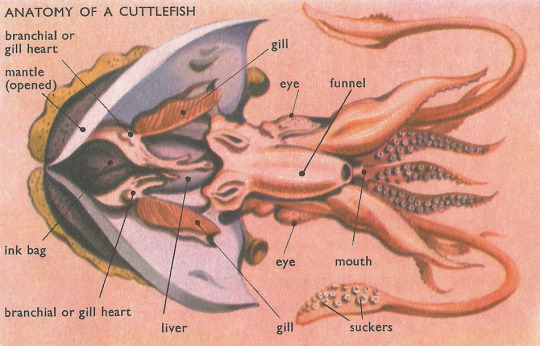
Image retrieved from: https://www.daviddarling.info/encyclopedia/C/cuttlefish.html
Secret Weapon
Since the cuttlefish is closely related to squids and octopi, it also has an ink sack that helps it ditch or distract predators who rely on sight. There are two ways to eject ink: one is to create a smoke screen behind the organism as it jets away or it can create a decoy by releasing ink in the form of pseudomorphs which are bubbles of ink surrounded by mucus that are about the same size as the cuttlefish. Dopamin and L-DOPA are present in the ink which can temporarily paralyze the sense of predators who hunt by smell.
youtube
Hairy details
There are lateral lines that consist of tiny hairs in the mantle of the cuttlefish that are sensitive to pressure waves. They are sensitive to 75 and 100 hz. These hair cells can be used as a defense mechanism by detecting movement of surrounding predators around the cuttlefish.
Mantle
Cuttlefish locomotion is heavily dependent on the mantle. When escaping predators, water is sucked into the cavity and the mantle muscles expel the liquid with great force so that the organism can move in the opposite direction. The water exits through the funnel which controls the angle of the spray. The mantle aids in respiration by bringing water up to the gills where oxygen is filtered and released into the bloodstream.
Reproductive organs
Males have a reproductive arm that inserts into the female’s buccal area, the area where the spermatophores are stored. Females accept more than one mate which leads the males to spray water through his mantle into the female’s buccal area to wash out other males’ spermatophores. Once ready to lay eggs, the female uses her arm to wipe the spermatophores onto the eggs.
Life as we know it
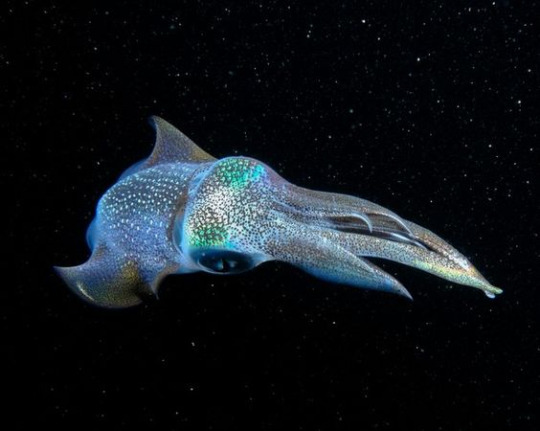
Image retrieved from: National Geographic Photo Contest 2019
In the springtime, after females lay their eggs they soon die. After two months, th eggs start to hatch. This process is highly dependent on water temperature. Once hatched, cuttlefish babies feed on small crustaceans and rapidly increase in size. Once big enough, the cuttlefish soon reach sexual maturity wherein the males mature much faster than the females. In ideal conditions the cuttlefish reach adulthood at 18-22 months. Their life span can reach 12-24 months
youtube
III. Relationship
Cuttlefish is an economically valuable marine species. Just like their cousins the squid and octopus, cuttlefish are a food source for humans. They are found in most temperate and tropical waters and the market for cuttlefish is large in Asian countries. In Japan, large cuttlefish are eaten raw as sashimi and the smaller ones are packed and frozen for cooking or sometimes dried (surume) (Nash & Thorpe, 2003).
The cuttlefish has an internal shell called the cuttlebone. This internal shell usually gets washed up to the shore and is picked up by beachgoers, collectors, and researchers. There aren’t many uses for the cuttlebone. Research on the effectiveness of cuttlebones as a supplement for caged birds are limited. However, from the research of Galal (2019), cuttlebone meal as dietary supplements for Japanese quails improves egg number and egg laying rate. There is also an increase in fertility rate and the body weight of the chicks.
Oil is also harvested from cuttlefish liver. In a journal article by Meivelu Moovendhan et al (2018), the oil from the liver of Sepia pharaonis was evaluated for its quality characteristics and biological activity. They found out that the oil contained Vitamins A and E, and nine fatty acids. Among the fatty acids present, Linoleic acid, DHA, and EPA had higher amounts.
According to Mehanna et al (2011), cuttlefish are overexploited in the Southeastern Mediterranean waters. The 45-day closed seasons are not effective, rather, they suggest that trawl selectivity should be improved. Also, the protection of spawning grounds through the establishment of MPA is necessary for improving stocks.
IV. Did you know?
Cuttlefish are also called “chameleons of the sea” because of their ability to camouflage. They can change their color through the help of specialized cells in their skin called chromatophores. Aside from color changing, they can also mimic the texture and shape of objects around them. They extend and retract their papillae in their body to change their skin’s texture.
Male cuttlefish change its color to attract femates. They can multitask, changing the color of half of their body to attract mates, while displaying aggressive coloration on the other side to ward off other males. In order to get a mate, a male cuttlefish also do “cross-dressing” and disguise himself as female. Since females only have three pairs of arms, a male even hides his fourth pair of arms and pretends like he’s carrying an egg. A real master of disguise!
Cuttlefish can hypnotize their potential prey by displaying pulsating light and color.
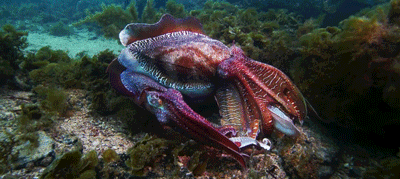
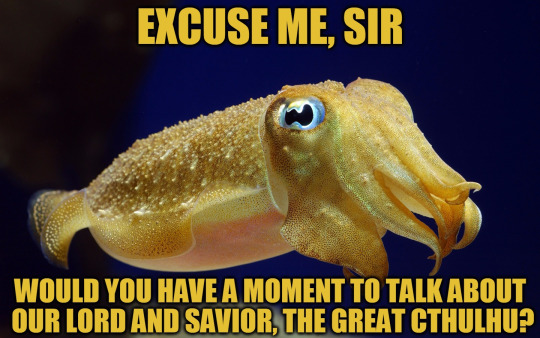
V. References
Compton, A. and L. Wiley (2011). "Sepia officinalis" (On-line), Animal Diversity Web. Retrieved October 08, 2020 from https://animaldiversity.org/accounts/Sepia_officinalis/
Geary, Daniel. (2015). Three hearts and blueish green blood… 10 fun facts about cuttlefish. Retrieved October 07, 2020 from https://atmosphereresorts.com/three-hearts-and-blueish-green-blood-10-fun-facts-about-cuttlefish/
Keyser, Hannah. (2015). 10 Colorful Facts About Cuttlefish. Retrieved October 07, 2020 from https://www.mentalfloss.com/article/66759/10-colorful-facts-about-cuttlefish
Mehanna, Sahar & Haggag, H. (2011). STOCK ASSESSMENT OF THE COMMON CUTTLEFISH, Sepia officinalis IN THE SOUTHEASTERN MEDITERRANEAN, EGYPT. Journal of Shellfish Research. 30. 1013-1013.
NOVA | Kings of Camouflage | Anatomy of a Cuttlefish (non-Flash) | PBS. (2007, March). Retrieved October 10, 2020, from https://www.pbs.org/wgbh/nova/camo/anat-nf.html
Reid, A., Jereb, P. and Roper, C.F.E (2005). “Cephalopods of the world. An annotated and illustrated catalogue of cephalopod species known to date. Volume 1. Chambered nautiluses and sepioids (Nautilidae, Sepiidae, Sepiolidae, Sepiadariidae, Idiosepiidae and Spirulidae).
Reproduction and Life Cycle. (n.d.). Retrieved October 10, 2020, from https://cuttlefishsepiida.weebly.com/reproduction-and-life-cycle.html
FAO Species Catalogue for Fishery Purposes. No. 4, Vol. 1. Rome, FAO. 2005. 262p. 9 colour plates. pp. 56 - 61.
4 notes
·
View notes